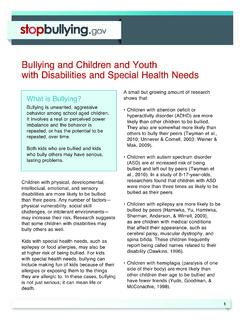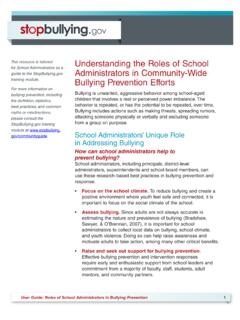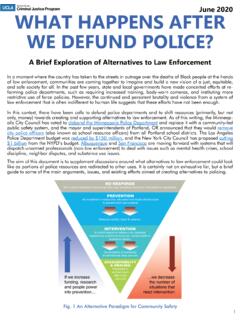Transcription of Understanding the Roles of Law Enforcement Officers in ...
1 1 User Guide: Roles of Law Enforcement Officers in Bullying PreventionUnderstanding the Roles of Law Enforcement Officers in Community-Wide Bullying Prevention EffortsWhat is known about bullying and how it relates to law Enforcement Officers ?Bullying affects a large number of students and may have a serious impact on those who are involved. In 2011, 28% of students aged 12-18 were bullied at school and 9% were cyberbullied anywhere (Robers, Kemp, Truman, & Snyder, 2013). Although traditionally, bullying has not been seen or treated as a criminal act, it has long been a concern of many in the law Enforcement community and some bullying behaviors may be illegal.
2 For example, acts of bullying may involve criminal acts, such as assault and battery, robbery, extortion, or threatening children who bully are at risk for engaging in other illegal, antisocial, or worrisome behavior that may come to the attention of those in the law Enforcement community. Children and youth who bully others are more likely than those who don t bully to get into fights, vandalize property, steal, and carry weapons; drop out of school ; use alcohol, cigarettes, and marijuana (Byrne, 1994; Haynie, Nansel, Eitel, Crump, Saylor, Yu, & Simons-Morton, 2001; Radliff, Wheaton, Robinson, & Morris, 2012). Those who bully others are also at higher risk of becoming involved in antisocial and criminal behavior later in their lives (L sel & Bender, 2011; Olweus, 1993; Ttofi, Farrington, L sel, & Loeber, 2011), including dating and intimate partner violence (Falb, McCauley, Decker, Gupta, Raj, & Silverman, 2011).
3 Being exposed as children to illegal activity, such as parents use of drugs and alcohol, domestic violence, and child maltreatment, also increases the likelihood that children will be involved in bullying either as a victim of bullying, as one who bullies others, or both (Baldry, 2003; Bowes, Arseneault, Maughan, Taylor, Caspi, & Moffitt, 2009; Holt, Kaufman Kantor, & Finkelhor, 2009; Shields & Cicchetti, 2001).This resource is tailored for Law Enforcement Officers as a guide to the training module. For more information on bullying prevention, including the definition, statistics, best practices, and common myths or misdirections, please consult the training module at Guide: Roles of Law Enforcement Officers in Bullying PreventionLaw Enforcement Officers Unique Role in Addressing BullyingHow can the law Enforcement community help to prevent bullying?
4 The school resource officer and other law Enforcement personnel who are interested in bullying prevention have many critical Roles . Not only must they carry out their sworn duty to enforce the law, they also must go beyond this traditional role to educate, prevent and solve problems, and provide resources (Rosiak, 2009). Effective prevention and response to bullying requires that law Enforcement personnel: Build positive relationships with students, teachers, parents, and others to help create a culture of tolerance and respect. Relationships are essential in a community- based policing approach. By getting to know students by name and working to build trusting relationships with them, law Enforcement Officers may help prevent bullying from happening in the first place.
5 Having a trusting relationship with a law Enforcement officer may increase the likelihood that children and youth will report bullying that they have experienced, witnessed, or suspected, or prevent it from taking place at all (Garrett, 2010). Engage in proactive activities to prevent bullying. By familiarizing themselves with best practices and common misdirections in bullying prevention and response, law Enforcement personnel can actively take part in school and community initiatives designed to reduce bullying and improve peer relations. Among the misdirections to avoid are harsh, inflexible discipline strategies, such as zero tolerance policies.
6 Such policies have been found to harm student-adult relationships, dampen school climate, and contribute to poor student achievement (APA Zero Tolerance Task Force, 2008). Instead, graduated sanctions should be used for rule violations, which are appropriate for the developmental level of the child and the nature and severity of the bullying. Become experts on the state s bullying law(s). Most states currently have a law addressing bullying at school , and many of them address bullying online. Be familiar with your state law(s), the differences between bullying, harassment and discrimination, and share this knowledge with others. Provide supervision, and be present and vigilant for warning signs.
7 The mere presence of an adult is often enough to deter bullying, and it is important to be seen as a safe adult who can be relied on to stop bullying. Law Enforcement personnel have skills in monitoring the behavior of large groups of individuals and being vigilant to signs of trouble. Know what locations in the school or community are particular hot spots for bullying. Increase supervision in these places but be aware that bullying can often migrate to new locations where adults are not Take part in efforts to investigate bullying and related behaviors. When bullying or other problematic behaviors are reported or suspected within a school , community, or online setting, law Enforcement personnel can work effectively with others to efficiently and thoroughly investigate the incident(s).
8 Take part in meetings with involved students and parents, where appropriate. Depending on the situation, it may be helpful for law Enforcement personnel to participate in meetings with youth who are involved with bullying, as well as with their parents. Take appropriate action if a crime is involved. If bullying behavior constitutes a crime, follow local laws and procedures to ensure public safety. Consider meeting with your prosecuting attorney to explore the possibility of instituting a behavior intervention plan instead of filing formal charges against youth. Removal from the school setting should be an option of last & Opportunities for the Law Enforcement Community Law Enforcement Officers and school personnel may face the following challenges in addressing bullying and other issues of school safety: Job responsibilities and expectations.
9 Law Enforcement Officers may have varying job responsibilities, missions, and professional cultures with different expectations regarding how bullying is defined, how it should be prevented, or what constitutes appropriate responses to bullying. school personnel and law Enforcement Officers often operate according to different rules. For example, law Enforcement Officers must uphold the law, and school officials have a school code of rules to enforce (Rosiak, 2009). Agreements between local law- Enforcement agencies and school districts can effectively define the role a school resource officer will play in assisting school personnel with discipline issues that do not involve violations of law or threaten security (National Association of school resource Officers , 2012).
10 Negative perceptions. Sometimes, there are negative community perceptions about law Enforcement personnel (Terrill & Reisig, 2003) and their Roles in schools and/or in working to address specific issues such as bullying (Rosiak, 2009). Despite these challenges, there is wide agreement among educators, law Enforcement personnel, and community members that students, families, and communities benefit from schools that are safe and that have positive climates for learning (Rosiak, 2009). Law Enforcement Officers are key players in efforts within schools and in the broader community to prevent and address the Law Enforcement Community Can Engage and Include Others in Community Bullying Prevention StrategiesPlanning community prevention strategies to address bullying requires engaging a host of stakeholders and developing partnerships with parents, youth, community leaders, and professionals across all disciplines.












